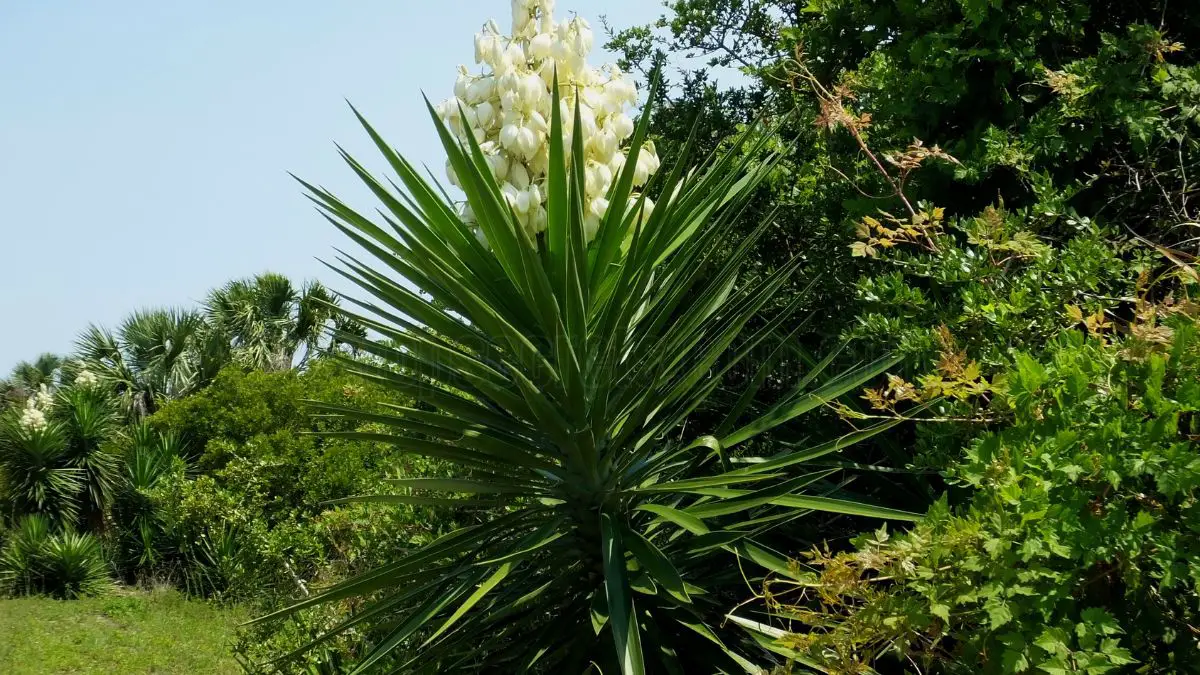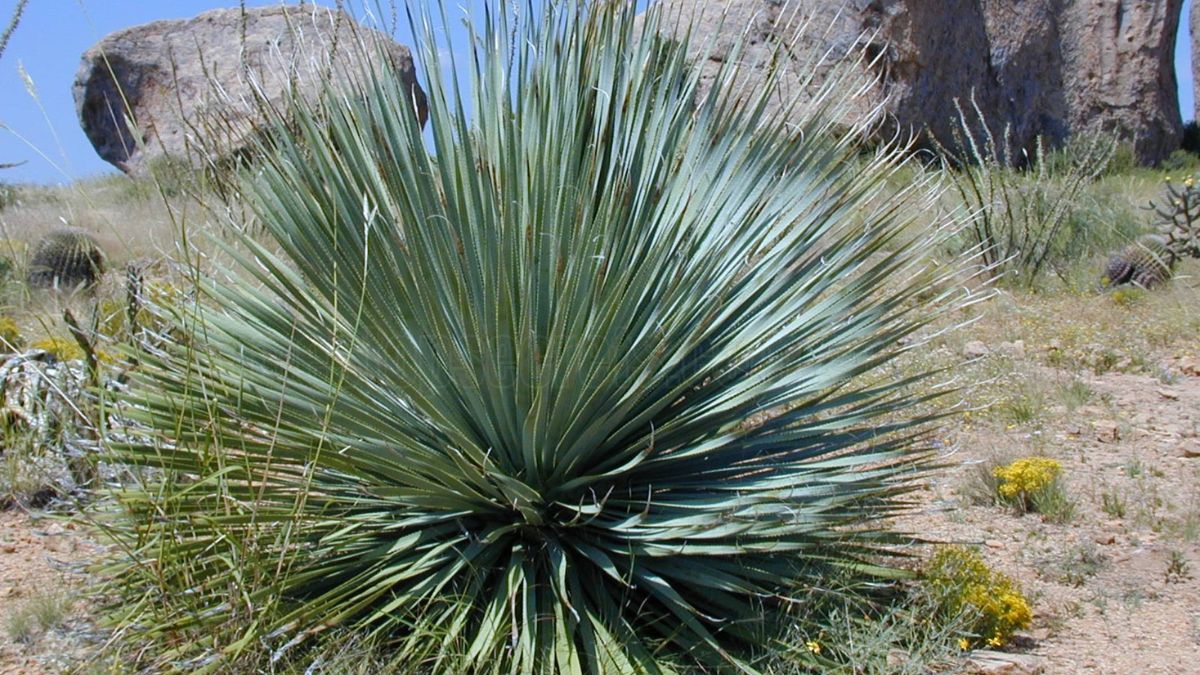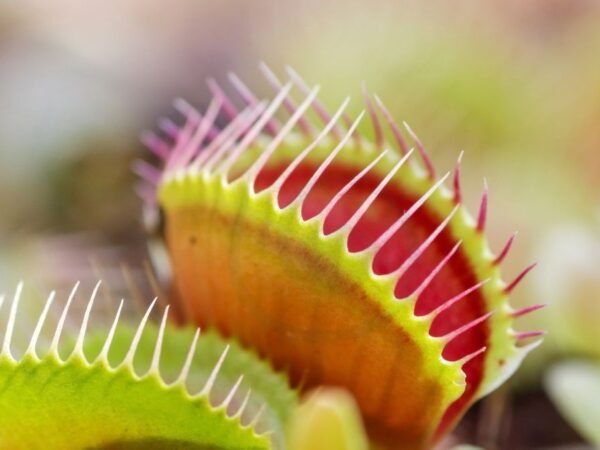Creating a suitable environment and regular care will help your outdoor yucca plants thrive. Native to the warm, dry desert climates, yuccas do best in very well-drained soil and don’t need much watering once established. Very drought tolerant, these tough plants love full sun, so plant them in the sunniest spots in your garden or landscape.
They benefit from regular pruning to keep them compact and shapely and to cause fresh growth to emerge. In addition, regular pest and disease inspections will ensure these beauties stay healthy and vibrant real gems!
Know what your yucca plant needs. Having this information will help you to design an attractive outdoor environment that highlights their distinct beauty. This guide will explore practical tips and strategies for successful yucca plant care, helping you cultivate these resilient plants in your garden.
Key Takeaways
- With their hardiness and versatility, outdoor yucca plants can be a stunning addition to any landscape. With interesting growth habits and the ability to flourish in virtually any environmental condition, these plants add remarkable beauty to the outdoor landscape.
- Knowing what yuccas need in terms of soil is key to their wellbeing. Choose soil that drains well and has a pH of 6.0 to 8.0 for best results and to avoid root problems.
- Yucca plants need to be in warm climates and are drought tolerant. Introduce thoughtful watering practices during periods of extreme heat and monitor for indicators of both overwatering and underwatering.
- Fertilization is an important aspect of yucca care. Use organic fertilizers to encourage robust growth, and use them sparingly so as not to scorch the roots.
- Consistent checks for pests and diseases will help keep yuccas thriving. Control pests with natural remedies and be proactive in identifying disease symptoms in order to take action early.
- Position and care for your outdoor yuccas with these tips to maximize growth and promote stunning blooms. Prune them back consistently and provide them with plenty of direct sunlight to thrive.
Understanding Outdoor Yucca Plants
Outdoor yucca plants are resilient, drought-tolerant members of the agave family, primarily found in dry regions of the Western Hemisphere. Defined by their architectural, sword-shaped leaves and stunning flower spikes, yuccas provide unparalleled beauty to xeriscapes. They do best in well-draining soil and prefer to be on the drier side, making them great candidates for low-maintenance, drought-tolerant gardens, especially in arid environments.
What are Outdoor Yucca Plants?
Yucca plants typically have long, rigid, sharp tipped leaves that can look very different from one species to the next. One great example is Adam’s Needle, known for spectacular flower spikes that shoot straight up to 6-8 feet tall. Other trees, in comparison, might only add an inch of growth per year.
Gardeners and landscapers alike love these plants, as they need very little water. Their towering presence and bold foliage allow them to hold their own as a centerpiece or border plant.
Types of Outdoor Yucca Plants in the U.S.
The most popular species in the U.S. Are the Spanish Bayonet and the Soapweed. Despite being very different in habitat, these plants easily adapt from sandy desert to rocky soil. While many do great in the dry Southwest, there are others more appropriate for the Southeast’s gentler weather patterns.
Therefore, knowing regional traits and characteristics are key to growing yucca successfully. Yucca plants need special treatment to thrive. They thrive in bright, dry conditions and are more prone to pests such as spider mites when overwatered or in humid environments.
With proper care, such as correct watering and some fertilization here and there, you can keep them healthy and vibrant.
Ideal Soil Conditions for Yucca
Yucca plants, particularly hardy varieties like the spineless yucca, are heavily impacted by their soil, which plays a key role in their overall health and lifespan. By understanding the specific needs of your yucca plant, you can ensure a robust and healthy outdoor yucca plant.
1. Best Soil Types for Yucca Growth
Yucca plants prefer sandy or loamy well-draining soil, which is an important factor in preventing root rot. Suitable soil types include sandy loam, rocky soil, and commercial cactus mix.
To enhance growth, consider amendments such as mixing peat moss and sand in a 3:1 ratio. This blend promotes aeration and drainage, both of which are important for yucca’s wellbeing.
To test if your soil is suitable, test drainage by pouring water into a hole. If it drains in less than an hour, you have the right soil type.
2. Soil pH and Drainage Requirements
The preferred soil pH for yucca is slightly acidic to neutral, in the range of 6.0 to 7.0. Inadequate drainage can result in waterlogged soil, encouraging root rot and other issues that can weaken or kill the yucca.
To ensure good drainage, mix in some perlite or gravel to the native soil. When you’re repotting, make a hole three times the width of the plant’s nursery pot. Ensure that the hole is as deep as the container so the roots can spread and prevent water pooling.
Yucca plants can grow in many different soil types, even rocky, as long as drainage is adequate. They like to be kept damp but not soggy, so let the soil dry out a bit between watering. Fertile soil isn’t required, and never over-fertilize yucca.
Climate Considerations for Yucca Care
Familiarizing yourself with the climate that outdoor yucca plants are naturally adapted to will help ensure proper care. These resilient plants are perfectly suited to today’s hotter, drier conditions. Though generally adapted to a range of conditions, yucca growing is highly susceptible to fluctuations in local weather patterns.
1. How Heat Affects Yucca Growth
Boiling temperatures, at least in the 90°F or higher range, are good for yuccas. They thrive in hot, dry climates, where they can soak up plenty of sun.
Drooping leaves or browning leaf tips are signs of heat stress that could develop. To reduce the risk of heat stress, water at regular intervals in periods of high heat, watering deeply to promote healthy root systems.
2. Managing Drought Conditions
These plants are naturally drought-tolerant, but they may still require special care during extended dry spells. Examples are putting down mulch to help the ground hold moisture during droughts and making sure that soil drains well so roots don’t rot.
Species such as the Yucca filamentosa, for example, show pronounced resistance to drought. A checklist could involve checking on plants regularly to catch signs of wilting early, or watering less if there’s been recent rainfall.
3. Protecting Yucca from Cold Temperatures
Though yuccas are hardy in cold, extreme cold can still be dangerous. To ensure that your plants are safe, insulate them by piling on mulch or straw in the late fall.
If you are in a particularly severe climate, bring them inside or into an unheated barn for winter. Cold-hardy species, like Yucca gloriosa, provide greater resistance to frost.
Effective Watering Practices

Whether succulent or flowering, it’s important to establish proper watering techniques to help outdoor yucca plants thrive in various environments. Determining a schedule that works for you, adjusting practices for the changing seasons, and learning to gauge the yucca plant's needs will all be essential parts of successful maintenance.
1. Watering Schedule for Healthy Yucca
Creating a consistent watering schedule will ensure healthy growth for your yucca. Here are recommended frequencies:
- Spring and Summer: Water every 1-2 weeks.
- Fall: Reduce to every 2-3 weeks.
- Winter: Water only when the soil is completely dry, typically every 3-4 weeks.
Temperature and humidity are two environmental factors that can affect how you adjust this schedule. For example, in extreme heat or drought conditions, yucca plants might need to be watered more often.
Soil moisture is the most important indicator of when to water—if the top inch or so of soil feels dry, it’s time to water. Bottom line—if it seems dry, don’t guess—water.
2. Signs of Overwatering and Underwatering
Knowing the indicators of overwatering is essential in order to protect against harm. Common symptoms of overwatering include leaves yellowing, stems becoming mushy, and soil developing a rotten smell.
Signs of yuccas being too dry include browning leaf tips, wilting, and stunted growth. To fix these problems, make sure your pots drain well and increase your interval between waterings.
A checklist can be helpful for evaluating watering needs:
- Inspect leaf color and texture.
- Check soil moisture levels.
- Assess plant growth patterns.
Fertilization Techniques for Yucca
Fertilization is one of the most important parts of yucca care, especially for the outdoor yucca plant, as it directly affects the plant’s growth, vigor, and overall health. With the proper fertilization, yuccas will be supplied with the necessary nutrients to promote vibrant growth and flowering, allowing yucca growing to flourish in an outdoor environment. Knowing when to fertilize and how much to apply will go a long way in making this resilient plant more rugged and attractive.
1. Best Organic Fertilizers for Yucca
- Compost
- Fish emulsion
- Bone meal
- Kelp meal
- Organic granular fertilizers
There are many benefits to using organic fertilizers rather than synthetic fertilizers. These benefits range from enriched soil health to a smaller carbon footprint. Organic fertilizers release their nutrients more slowly, giving the plant a consistent supply while reducing the danger of over-fertilizing.
When it comes to dosage, follow instructions on the package for application. Fertilize during the growing season to make sure nutrients are available when your plants need them the most.
2. Avoiding Root Burn with Fertilizers
Root burn on yucca plants often happens when too much fertilizer is used over time. This causes nutrients to accumulate and draw moisture away from the roots. To avoid burning your yucca plants, always use fertilizers at the suggested application rates.
Always water the plant deeply before and immediately after applying yucca fertilizer to prevent plant stress. Check your soil moisture daily at first. Monitor your plants for signs that they are being over-fertilized, such as wilting or browning of leaf tips, and modify your application methods accordingly.
Pest and Disease Management
Overall, effective pest and disease management is crucial for maintaining healthy outdoor yucca plants. Understanding the pests and diseases common to your yucca species allows you to implement proper detection and control measures, ensuring a strong and resilient plant!
1. Common Pests Affecting Outdoor Yucca
Several pests frequently attack the outdoor yucca. These include spider mites, mealybugs, and aphids. Initial signs of infestations will usually appear as yellowing leaves, webbing, or sticky residue on the plant. That’s why early detection is so important.
Make sure to check the undersides of leaves and stems, looking for any unexpected movement or signs of injury. Periodic inspections can identify potential problems before they become disasters.
2. Natural Remedies for Pest Control
Natural remedies for yucca pest control are extremely useful and powerful. Bring in predatory bugs like ladybugs that feed on aphids. You can likewise spray insecticidal soap to repel bugs without damaging your plants.
The advantages of using organic solutions are less exposure to chemicals and harm to the environment. You can help keep them resistant by rotating your plants to new locations each year. Keep optimal air circulation and a clean garden environment to prevent most problems.
3. Identifying and Treating Diseases
Yucca plants, particularly the stunning yucca species, may be prone to diseases like leaf spot and root rot. Symptoms can manifest as yellow or brown spots on the foliage and wilting. Identifying these signs early can help you take action quickly, ensuring your resilient plant remains healthy and vibrant.
Treatment options include removing infected vegetation and maintaining good drainage, which is essential for preventing root rot in hardy plants like yucca.
Pruning and Maintenance Strategies
Pruning and maintenance are crucial for caring for the yucca plant, whether it's grown indoors or outdoors, promoting a healthy and attractive appearance. Routine maintenance not only encourages healthy growth but also enhances the beauty of this stunning plant. Understanding the right tools and maintenance chores will ensure your yucca thrives beautifully.
1. When and How to Prune Yucca Plants
The best time to prune yucca plants is in early spring before new growth begins. This timing ensures that the plant can heal and thrive with the onset of warmer weather. Use sharp, clean pruning shears to avoid damaging the plant.
Cut dead or damaged leaves at the base, ensuring to leave healthy foliage intact. A checklist for assessing when pruning is necessary includes: observing yellowing leaves, noticing excessive height, or identifying overcrowding in the center of the plant.
2. Techniques for Aesthetic Trimming
Technique #1 – Aesthetic TrimmingYucca plants, in particular, can look unattractive with all their dead leaves hanging down. Techniques like trimming the leaves to different heights add a more natural, less uniform, dynamic appearance.
Shaping yucca consists of removing lower leaves to spotlight the plant’s unique structure, letting it shine in the garden. Inspect your yucca garden regularly for dead leaves and debris to maintain a neat appearance.
Prevent surrounding vegetation from stealing the show from your yucca. Regular pruning and maintenance of yucca plants fosters plant health and makes a great addition to an eye-catching landscape design.
Placement and Environmental Factors
Proper placement of yucca plants in the landscape makes a difference on how well they thrive and their ability to deter unwanted pests. These resilient plants grow only in carefully controlled environmental conditions that play an enormous role in their cultivation.
Being aware of these factors can help you reach your goal of successful cultivation and a beautiful, productive garden.
1. Optimal Sun Exposure for Yucca
Yucca plants need full sun exposure to thrive, getting at least six hours of direct sunlight per day at minimum. Not enough light will cause your plant to grow leggy and reduce flowering, while too much sun can cause leaf scorch.
Keeping a close eye on how much light your plant receives is crucial. To provide the correct amount of light, sunlight is the most important factor for plant growth.
Next, determine where the shaded areas will be and select sites far enough from taller vegetation to avoid competition for sunlight.
2. Wind Protection Strategies
High winds can become a threat to yuccas, uprooting them entirely or shredding leaves by impact. To protect against these risks, gardeners can use a combination of wind protection strategies.
By strategically planting yucca behind windbreaks, including fences or taller native plants, they can be protected from severe winds. Implementing these strategies using additional stakes or protective barriers, particularly during extreme weather events, can offer additional protection.
Begin by evaluating the site’s level of exposure to prevailing winds. Next, identify existing buildings or other features that might offer them windbreak, and take into account your region’s climate when choosing where to locate your plants.
Propagation Methods for Outdoor Yucca
Developing new outdoor yucca plants can be done in several ways, each offering distinct benefits. Getting to know these propagation methods will take your green thumb to the next level and help you create a dynamic and beautiful landscape.
Here are the main techniques to know, and crucial propagating checklists, for achieving great propagation.
1. Seed Propagation Techniques
The first step in propagating yucca from seeds is harvesting mature seeds from older plants. Once harvested, soak the seeds in water for 24 hours before planting. This weakens the seed coat and encourages germination.
The perfect environment for germinating seeds is fast-draining soil, moderate temps of around 70-80°F, and even moisture. Be sure to check on your seeds often to look for any germination and provide them sufficient light while protecting them from intense direct sun.
Checklist for Monitoring Seed Propagation:
- Soak seeds for 24 hours before planting.
- Use sterile, well-draining soil.
- Maintain temperature between 70-80°F.
- Keep the soil consistently moist but not soggy.
- Provide indirect sunlight for optimal growth.
2. Offsets and Division Methods
Offsets, or pups, are small plants that branch off at the base of the parent yucca. To propagate through offsets, gently remove these pups from the mother plant in spring or early summer.
It’s a great method to promote faster establishment and produce more vigorous plants. Dividing mature yucca plants not only supports propagation efforts, but it improves growth by alleviating root crowding.
Checklist for Successful Division Propagation:
- Choose healthy, mature plants for division.
- Separate offsets carefully without damaging roots.
- Prepare a new planting site with well-draining soil.
- Water thoroughly after planting.
- Monitor for signs of stress or transplant shock.
Companion Planting and Landscaping Integration
Integrating the outdoor yucca plant with companion planting in the landscape encourages biodiversity, enhancing the long-term health of the garden. By strategically pairing this stunning plant with other varieties, gardeners can create a more resilient ecosystem that thrives in urban and suburban settings.
1. Benefits of Companion Planting with Yucca
Combining yucca with other drought-tolerant plants, such as lavender or rosemary, can yield multiple benefits. These plants have the same water and sun needs, minimizing redundancy and maximizing the ecosystem.
Companion plants help ward off pests that plague yucca, including aphids or mealybugs. When planning out your companion planting, keep in mind a short checklist of factors such as plant height, root depth, and how the plants grow.
This makes the integration work and allows all plants to thrive together without competing for resources.
2. Sustainable Landscaping Practices with Yucca
Incorporating yucca as part of a sustainable landscape design is an asset to aesthetics and ecology. Yucca is very low water, as well as being very tolerant of bad soil which makes it a fantastic option for xeriscaping.
It truly is a win-win. This practice saves water, encourages the growth of native plant species and supports the wildlife in their environment.
A companion planting and landscaping integration checklist for sustainable strategy implementation should involve evaluating soil conditions, choosing native companion plants, and planning for seasonal variation.
This strategy not only saves resources, but it increases the landscape’s ability to bounce back from stresses.
Conclusion
By following these tips, caring for outdoor yucca plants can be a rewarding experience that adds beauty and interest to your garden. By adhering to these soil, watering, fertilization, and pest control techniques, you’ll be well on your way to providing a healthy environment for your yuccas. Place your yucca plants where they will thrive best. Regular pruning and care will help ensure they remain healthy and attractive. Think about companion planting to add more color and depth to your garden.
By following this advice, you’ll not only keep your yucca happy, but create a thriving outdoor environment. Enter the colorful world of yucca care with ease and confidence. Get started now and reap the benefits of your hard work. Either way, your garden will thank you for it.
Frequently Asked Questions
What type of soil is best for outdoor yucca plants?
What type of soil is best for outdoor yucca plants? A pH range of 6.0 to 8.0 is perfect, as well as keeping their roots dry and free from rot.
How much sunlight do yucca plants need?
Yucca plants thrive in full sun, needing a minimum of 6 hours of direct sunlight each day, making them resilient plants that are perfect for xeriscape gardens and hardy landscapes.
How often should I water my yucca plants?
Yucca plants, particularly the hardy varieties, thrive when watered sparingly. The key is to let the soil dry out completely in between waterings, typically every 2-3 weeks, depending on rainfall.
When is the best time to fertilize yucca plants?
The best time to fertilize yucca plants, particularly the stunning yucca species, is in the spring and early summer with a balanced fertilizer, promoting lush growth during their active summer growing season.
How do I manage pests on my yucca plants?
Check often for pests such as aphids or spider mites. Treat with insecticidal soap or neem oil. Providing adequate air movement around your yucca plants will deter most infestations before they start.
Should I prune my yucca plants?
Should I prune my yucca plants? It’s best to perform this maintenance on hardy plants in late winter or early spring before new growth begins.
Can I propagate yucca plants easily?
Can I propagate my outdoor yucca plants easily? It’s as simple as removing the pups from the parent plant and transplanting them into well-draining soil.
Image Source: Paid image from CANVA




